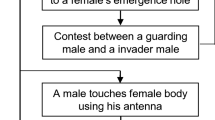Abstract
Because only the first mating results in fertilization in Tetranychus kanzawai (Acari: Tetranychidae), adult males guard quiescent deutonymph females (i.e., precopulatory mate guarding). A previous study reported that quiescent deutonymph females guarded by a male attract more conspecific males than solitary females and then hypothesized that guarded females release more chemical signals than solitary ones to attract males. Quiescent deutonymph females do not feed. If the hypothesis is appropriate, guarded females should invest energy in attracting males at the expense of investment in other activities, such as egg production. Therefore, we compared oviposition rates immediately after adult emergence between guarded females and solitary females. On the first day, the oviposition rate of guarded females was lower than that of solitary females. On the second day, however, there was no significant difference between female groups. These results suggest that guarded females invest energy in activities other than egg production before adult emergence and that the energetic cost is easily recoverable. We believe that our finding indirectly supports the hypothesis that guarded females release more chemical signals than solitary females to attract conspecific males.


Similar content being viewed by others
References
Cone WW (1985) Mating and chemical communication. In: Helle W, Sabelis MW (eds) Spider mites: their biology, natural enemies and control, vol 1A. Elsevier, Amsterdam, pp 243–251
Cone WW, McDounough LM, Maitlen JC, Burdajewicz S (1971) Pheromone studies of the two-spotted spider mite, Tetranychus urticae Koch. I. Evidence of a sex pheromone. J Ecol Entomol 64:355–358
Cox RM, Parker EU, Cheney DM, Liebl AL, Martin LB, Calsbeek R (2010) Experimental evidence for physiological costs underlying the trade-off between reproduction and survival. Funct Ecol 24:1262–1269
Everson PR, Addicott JF (1982) Mate selection strategies by male mites in the absence of intersexual selection by females: a test of six hypotheses. Can J Zool 60:2729–2736
Johansson BG, Jones TM (2007) The role of chemical communication in mate choice. Biol Rev 82:265–289
Nespolo RF, Roff DA, Fairbairn DJ (2008) Energetic trade-off between maintenance costs and flight capacity in the sand cricket (Gryllus firmus). Funct Ecol 22:624–631
Ohzora Y, Yano S (2008) Fertilization of two-spotted spider mite mothers changes sons. J Acarol Soc Jpn 17:87–92
Oku K (2008) Is only the first mating effective for females in the Kanzawa spider mite, Tetranychus kanzawai (Acari: Tetranychidae)? Exp Appl Acarol 45:53–57
Oku K (2009a) Female mating strategy during precopulatory mate guarding in spider mites. Anim Behav 77:207–211
Oku K (2009b) Effects of density experience on mate guarding behaviour by adult male Kanzawa spider mites. J Ethol 27:279–283
Potter DA, Wrensch DL, Johnston DE (1976) Guarding, aggressive behavior, and mating success in male twospotted spider mites. Ann Entomol Soc Am 69:707–711
Povey SR, Holloway GJ (1992) The effect of energy trade-offs on life history and fitness in the rice weevil, Sitophilus oryzae. Oikos 63:441–450
R Development Core Team (2010) R: A Language and Environment for Statistical Computing. R Foundation for Statistical Computing, Vienna
SAS Institute (2009) JMP: statics graphics guide, version 8.0.2. SAS Institute, Cary
Acknowledgments
We thank Dr. S. Yano of Kyoto University for keeping mites for more than 4 years, Mrs. K. Kanbe of National Agricultural Research Center for rearing plants, and Dr. A. S. Tanabe of Kyoto University and Dr. E. H. Poelman of Wageningen University for their valuable comments. We also thank Dr. P. W. de Jong of Wageningen University for reading and correcting our manuscript and two anonymous reviewers for their comments.
Author information
Authors and Affiliations
Corresponding author
Rights and permissions
About this article
Cite this article
Oku, K., Shimoda, T. Indirect evidence that guarded quiescent deutonymph females invest energy to attract conspecific males in the Kanzawa spider mite (Acari: Tetranychidae)?. Exp Appl Acarol 60, 445–449 (2013). https://doi.org/10.1007/s10493-013-9662-1
Received:
Accepted:
Published:
Issue Date:
DOI: https://doi.org/10.1007/s10493-013-9662-1




